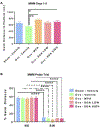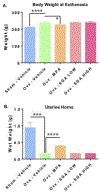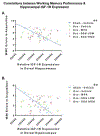Evaluations of memory, anxiety, and the growth factor IGF-1R after post-surgical menopause treatment with a highly selective progestin
- PMID: 37085118
- PMCID: PMC11105077
- DOI: 10.1016/j.bbr.2023.114442
Evaluations of memory, anxiety, and the growth factor IGF-1R after post-surgical menopause treatment with a highly selective progestin
Abstract
Progestogens are a key component of menopausal hormone therapies. While some progestogens can be detrimental to cognition, there is preclinical evidence that progestogens with a strong progesterone-receptor affinity benefit some molecular mechanisms believed to underlie cognitive function. Thus, a progestin that maximizes progesterone-receptor affinity and minimizes affinities to other receptors may be cognitively beneficial. We evaluated segesterone-acetate (SGA), a 19-norprogesterone derivative with a strong progesterone-receptor affinity and no androgenic or estrogenic-receptor activity, hypothesizing that it would enhance cognition. Middle-aged rats underwent Sham or Ovariectomy (Ovx) surgery followed by administration of medroxyprogesterone-acetate (MPA; used as a positive control as we have previously shown MPA-induced cognitive deficits), SGA (low or high dose), or vehicle (one Sham and one Ovx group). Spatial working and reference memory, delayed retention, and anxiety-like behavior were assessed, as were memory- and hormone- related protein assays within the frontal cortex, dorsal hippocampus, and entorhinal cortex. Low-dose SGA impaired spatial working memory, while high-dose SGA had a more extensive detrimental impact, negatively affecting spatial reference memory and delayed retention. Replicating previous findings, MPA impaired spatial reference memory and delayed retention. SGA, but not MPA, alleviated Ovx-induced anxiety-like behaviors. On two working memory measures, IGF-1R expression correlated with better working memory only in rats without hormone manipulation; any hormone manipulation or combination of hormone manipulations used herein altered this relationship. These findings suggest that SGA impairs spatial cognition after surgical menopause, and that surgical menopause with or without progestin administration disrupts relationships between a growth factor critical to neuroplasticity.
Keywords: Learning; Memory; Ovariectomy; Progestin; Rat; WRAM.
Copyright © 2023 Elsevier B.V. All rights reserved.
Conflict of interest statement
Declarations of interest None.
Figures









Similar articles
-
Medroxyprogesterone acetate impairs memory and alters the GABAergic system in aged surgically menopausal rats.Neurobiol Learn Mem. 2010 Mar;93(3):444-53. doi: 10.1016/j.nlm.2010.01.002. Epub 2010 Jan 13. Neurobiol Learn Mem. 2010. PMID: 20074654 Free PMC article.
-
A comparison of progestins within three classes: Differential effects on learning and memory in the aging surgically menopausal rat.Behav Brain Res. 2017 Mar 30;322(Pt B):258-268. doi: 10.1016/j.bbr.2016.06.053. Epub 2016 Jun 28. Behav Brain Res. 2017. PMID: 27368418 Free PMC article.
-
Transitional versus surgical menopause in a rodent model: etiology of ovarian hormone loss impacts memory and the acetylcholine system.Endocrinology. 2009 Sep;150(9):4248-59. doi: 10.1210/en.2008-1802. Epub 2009 May 21. Endocrinology. 2009. PMID: 19470706 Free PMC article.
-
Preclinical evaluation of norgestimate, a progestin with minimal androgenic activity.Am J Obstet Gynecol. 1992 Oct;167(4 Pt 2):1191-6. doi: 10.1016/s0002-9378(12)90410-x. Am J Obstet Gynecol. 1992. PMID: 1415445 Review.
-
Comparative cardiovascular effects of different progestins in menopause.Int J Fertil Womens Med. 2001 Sep-Oct;46(5):248-56. Int J Fertil Womens Med. 2001. PMID: 11720197 Review.
References
-
- Pinkerton JV, Sánchez Aguirre F, Blake J, Cosman F, Hodis H, Hoffstetter S, Kaunitz AM, Kingsberg SA, Maki PM, Manson JE, Marchbanks P, McClung MR, Nachtigall LE, Nelson LM, Todd Pace D, Reid RL, Sarrel PM, Shifren JL, Stuenkel CA, Utian WH, The 2017 hormone therapy position statement of The North American Menopause Society, Menopause. 24 (2017) 728–753. 10.1097/GME.0000000000000921. - DOI - PubMed
-
- El Khoudary SR, Greendale G, Crawford SL, Avis NE, Brooks MM, Thurston RC, Karvonen-Gutierrez C, Waetjen LE, Matthews K, The menopause transition and women’s health at midlife: A progress report from the Study of Women’s Health across the Nation (SWAN), Menopause. 26 (2019) 1213–1227. 10.1097/GME.0000000000001424. - DOI - PMC - PubMed
-
- Gleason CE, Dowling NM, Wharton W, Manson JAE, Miller VM, Atwood CS, Brinton EA, Cedars MI, Lobo RA, Merriam GR, Neal-Perry G, Santoro NF, Taylor HS, Black DM, Budoff MJ, Hodis HN, Naftolin F, Harman SM, Asthana S, Effects of hormone therapy on cognition and mood in recently postmenopausal women: findings from the randomized, controlled KEEPS–cognitive and affective study, PLoS Med 12 (2015) 1–26. 10.1371/journal.pmed.1001833. - DOI - PMC - PubMed
-
- Maki PM, Dennerstein L, Clark M, Guthrie J, LaMontagne P, Fornelli D, Little D, Henderson VW, Resnick SM, Perimenopausal use of hormone therapy is associated with enhanced memory and hippocampal function later in life, Brain Res 1379 (2011) 232–243. 10.1016/j.brainres.2010.11.030. - DOI - PMC - PubMed
Publication types
MeSH terms
Substances
Grants and funding
LinkOut - more resources
Full Text Sources
Research Materials

